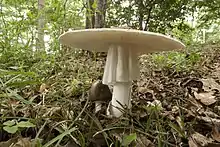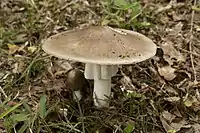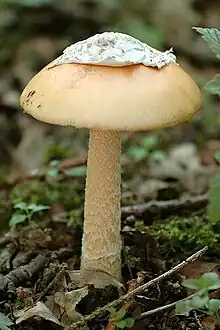Amanita pseudoporphyria
Amanita pseudoporphyria, also known as Hongo's false death cap, is a species of agaric fungus from the genus Amanita that grows solitarily or gregarious in coniferous forests. Originally described from Japan, it is now also known in Northern India, Thailand, and Nepal. It is quite a common species in southern China and is sold in free markets, along with the similar mushroom, Amanita manginiana. It differs only slightly by having more abundant inflated cells of its volva, and its ellipsoid to broad ellipsoid spores.[1]
| Amanita pseudoporphyria | |
|---|---|
 | |
| Scientific classification | |
| Domain: | Eukaryota |
| Kingdom: | Fungi |
| Division: | Basidiomycota |
| Class: | Agaricomycetes |
| Order: | Agaricales |
| Family: | Amanitaceae |
| Genus: | Amanita |
| Species: | A. pseudoporphyria |
| Binomial name | |
| Amanita pseudoporphyria Hongo (1957) | |
| Amanita pseudoporphyria | |
|---|---|
| Gills on hymenium | |
| Hymenium attachment is not applicable | |
| Stipe has a ring and volva | |
| Ecology is mycorrhizal | |
| Edibility is poisonous | |
Toxicity
A. pseudoporphyria has been known to be poisonous.
Nephrotoxin poisoning in 66-year-old man
There has been a case of nephrotoxin poisoning, including delayed onset acute kidney failure associated with the ingestion of this mushroom in a 66-year-old man with diabetes. Effects occurred similar to that of the intoxication symptoms associated with the North American species Amanita smithiana and the Mediterranean Amanita proxima. Kidney biopsy of the patient showed acute tubular necrosis with glomerular minor abnormalities. Treatment included a three-week period of haemodialysis, after which the patient fully recovered from the acute kidney failure in two months.[2]
Dried mushrooms bought online
Scientists conducted an analysis on several commercially produced processed food items containing mushrooms, including a bag of what was claimed to be dried "porcini mushrooms", which was bought online. After DNA analysis, it was confirmed the bag contained A. pseudoporphyria, as well as Tylopilus microsporus, Caloboletus yunnanensis and Retiboletus fuscus. Several customers have left reviews of this product, writing about their experience with the mushrooms. They have described the mushrooms as having "an extremely bitter flavor with a bad aftertaste", and some claimed that they were "poisoned" and had “never been so sick in my life”. One customer even said that “the package I rec’d included a mashed cigarette butt”. In July 2019, the scientists reached out to the online retailer from which the product was bought from to inform them of their findings. As of 2021, the product is still for sale.[3]
See also
References
- Tulloss R. "Amanita pseudoporphyria". Amanitaceae.org. Retrieved 2012-02-25.
- Iwafuchi Y, Morita T, Kobayashi H, Kasuga K, Ito K, Nakagawa O, Kunisada K, Miyazaki S, Kamimura A (2003). "Delayed onset acute renal failure associated with Amanita pseudoporphyria Hongo ingestion". Internal Medicine. 42 (1): 78–81. doi:10.2169/internalmedicine.42.78. PMID 12583624.
- Ii, W. Dalley Cutler; Bradshaw, Alexander J.; Dentinger, Bryn T. M. (2021-08-02). "What's for dinner this time?: DNA authentication of "wild mushrooms" in food products sold in the USA". PeerJ. 9: e11747. doi:10.7717/peerj.11747. ISSN 2167-8359. PMC 8340906. PMID 34414024.



